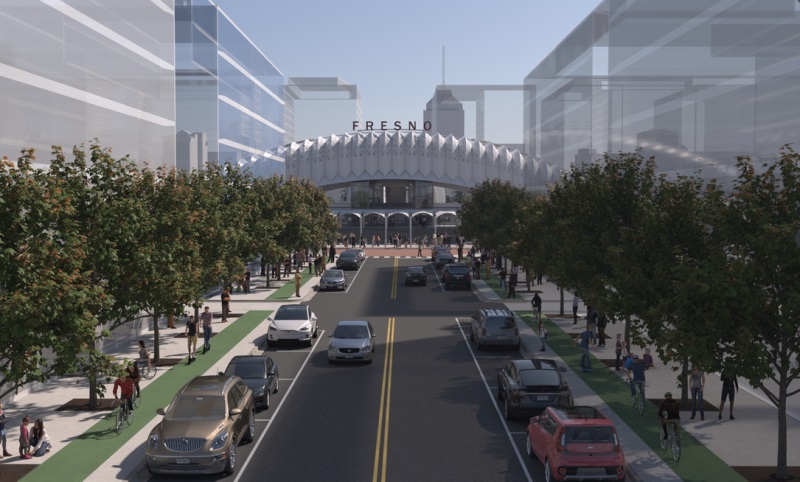This week, the California High-Speed Rail Authority certified the final Environmental Impact Report for the ninety-mile segment from San Jose to Merced through the Pacheco Pass.
This means that environmental work has been completed on nearly 400 of the 500-mile Phase 1 alignment from San Francisco to Anaheim. The segments that still need to be cleared environmentally are from San Jose to San Francisco, Los Angeles to Anaheim, and Palmdale to Burbank. The environmental impact report for the first of those is expected to be approved sometime this year, with the other two coming in 2023 and 2024, respectively. The EIR for the section between Burbank and L.A. was certified earlier this year.
Four project alignments were studied for the San Jose-to-Merced segment, with differences between San Jose and Gilroy. All the alternatives included about fifteen miles of tunnels through the Pacheco Pass in the Central Valley.
The board selected "Alternative 4" as the preferred alternative - see map below. It takes a big turn just south of Gilroy, after emerging from a tunnel west of Casa de Fruta and before pulling into the planned Gilroy station. From there, the alignment is mostly at grade through Gilroy, Morgan Hill, and San Martin, all the way into San Jose's Diridon Station.
Residents of these areas raised concerns about displacement, at-grade safety, noise, and wildlife impacts, among other issues. This alternative was chosen because it has the least number of displacements (it estimates having to displace 68 residences and an equal number of businesses), takes over the least amount of farmland, and has the least impact on wildlife corridors.
It is not the quietest of the alternatives, because several of the other ones considered including tunnels along this segment. It includes some noise barriers, which are not as effective as tunnels, but tunnels would have been "prohibitively expensive" according to the EIR. The selected alternative was laso the least expensive overall, with an estimated cost of $19 billion.
It will also involve about fifteen permanent road closures.
The board's approval brings to a close analyses that have been ongoing since 2005, with serious discussions of alternative alignments since 2009.
At the board meeting, several people, including former CAHSRA chair Ron Diridon (for whom the San Jose train station is named), reminded the board that it was important to keep in mind the federal money that will soon be available for "shovel ready" projects. "Delays are deadly," he said. "As you consider this environmental work - which is important - whatever you do, do not delay the project," which he called California's "number one remedy for climate."
L.A. Union Station Funding
At the same meeting, the CAHSRA board also approved an agreement with L.A. Metro to fund the modernization of Union Station with the planned Link US run-through-tracks project. Link US will change the configuration of tracks at Union Station to allow trains, including high-speed trains, to enter and exit from both ends. Right now trains can only enter from the north; they have to reverse and loop around the station to head south to Anaheim and San Diego.
The agreement secures $423 million from Prop 1A - the bond funding that started the California High-Speed Rail program - for Union Station improvements. It follows on a recent agreement between CAHSRA and L.A. Metro to pursue shared use of rights-of-way through Union Station, Palmdale, and other locations.
🚨 The Authority Board approved an agreement with @metrolosangeles to advance the Link Union Station project in Southern California!
— CA High-Speed Rail 🚄💨 (@CaHSRA) April 27, 2022
💵 The Authority will invest $423 million in Prop 1A funds towards modernizing LA Union Station.
🔗 More: https://t.co/o4RvOsL5Uo@Metrolink pic.twitter.com/OOgiub9Qk6
Central Valley Station Designs
Staff released conceptual drawings for four Central Valley stations: Merced, Fresno, Kings-Tulare, and Bakersfield, and the board gave the nod to starting the process of hiring firms to to design and build the new stations.
Renderings for the Fresno station show separated bike lanes, canopies, bus lanes, and bus boarding islands. There will be opportunities for public input on station access and other design elements after consultants are chosen. Construction on the Fresno station is estimated to begin in 2025.
2022 Business Plan
The board also approved the 2022 Business Plan. The plan lays out timelines and funding sources for the project, including the allocation of remaining Prop 1A funds and potential federal funding that California is in a good position to compete for, as well as $965 million from the cap-and-trade program.
Director Margaret Peña was the only director who did not support adoption of the plan, because, she said, like last year it defers fiscal action updates until 2023 - in particular the $4.2 billion in Prop 1A funds. It is still not clear whether this allocation will be approved, she said, "and I know that the Assembly is looking for specific ways to spend those dollars on other things. In addition, the federal funds are still uncertain."
The board adopted the plan. But expect another round of budget negotiations over allocating the Prop 1A funds, which were not released last year. However, since some of that money will go to the L.A. Union Station project - as per the item above - maybe southern California Assemblymembers will be able to see the benefits of allocating those funds a little better than they could last year.
Carbon Footprint of Traveling by Electric Rail
One more CAHSRA bit of news: for Earth Day last week, the Authority released a "carbon footprint calculator" showing the differences in carbon produced via driving, flying, or taking the future electric train. A round trip by the train between San Francisco and Anaheim would save 389 pounds of carbon vs. traveling by plane or car.







